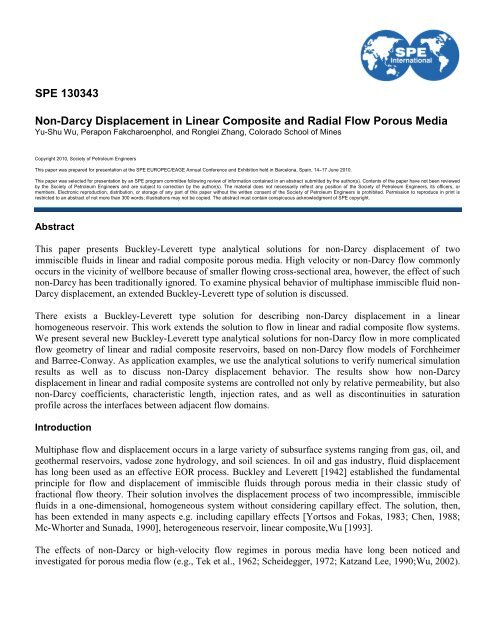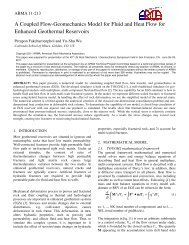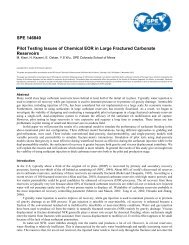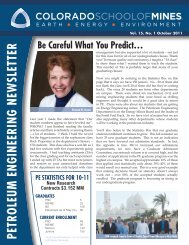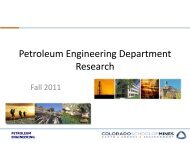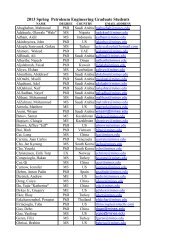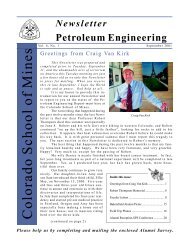SPE International Symposium & Exhibition on Formation Damage ...
SPE International Symposium & Exhibition on Formation Damage ...
SPE International Symposium & Exhibition on Formation Damage ...
You also want an ePaper? Increase the reach of your titles
YUMPU automatically turns print PDFs into web optimized ePapers that Google loves.
<str<strong>on</strong>g>SPE</str<strong>on</strong>g> 130343<br />
N<strong>on</strong>-Darcy Displacement in Linear Composite and Radial Flow Porous Media<br />
Yu-Shu Wu, Perap<strong>on</strong> Fakcharoenphol, and R<strong>on</strong>glei Zhang, Colorado School of Mines<br />
Copyright 2010, Society of Petroleum Engineers<br />
This paper was prepared for presentati<strong>on</strong> at the <str<strong>on</strong>g>SPE</str<strong>on</strong>g> EUROPEC/EAGE Annual C<strong>on</strong>ference and <str<strong>on</strong>g>Exhibiti<strong>on</strong></str<strong>on</strong>g> held in Barcel<strong>on</strong>a, Spain, 14–17 June 2010.<br />
This paper was selected for presentati<strong>on</strong> by an <str<strong>on</strong>g>SPE</str<strong>on</strong>g> program committee following review of informati<strong>on</strong> c<strong>on</strong>tained in an abstract submitted by the author(s). C<strong>on</strong>tents of the paper have not been reviewed<br />
by the Society of Petroleum Engineers and are subject to correcti<strong>on</strong> by the author(s). The material does not necessarily reflect any positi<strong>on</strong> of the Society of Petroleum Engineers, its officers, or<br />
members. Electr<strong>on</strong>ic reproducti<strong>on</strong>, distributi<strong>on</strong>, or storage of any part of this paper without the written c<strong>on</strong>sent of the Society of Petroleum Engineers is prohibited. Permissi<strong>on</strong> to reproduce in print is<br />
restricted to an abstract of not more than 300 words; illustrati<strong>on</strong>s may not be copied. The abstract must c<strong>on</strong>tain c<strong>on</strong>spicuous acknowledgment of <str<strong>on</strong>g>SPE</str<strong>on</strong>g> copyright.<br />
Abstract<br />
This paper presents Buckley-Leverett type analytical soluti<strong>on</strong>s for n<strong>on</strong>-Darcy displacement of two<br />
immiscible fluids in linear and radial composite porous media. High velocity or n<strong>on</strong>-Darcy flow comm<strong>on</strong>ly<br />
occurs in the vicinity of wellbore because of smaller flowing cross-secti<strong>on</strong>al area, however, the effect of such<br />
n<strong>on</strong>-Darcy has been traditi<strong>on</strong>ally ignored. To examine physical behavior of multiphase immiscible fluid n<strong>on</strong>-<br />
Darcy displacement, an extended Buckley-Leverett type of soluti<strong>on</strong> is discussed.<br />
There exists a Buckley-Leverett type soluti<strong>on</strong> for describing n<strong>on</strong>-Darcy displacement in a linear<br />
homogeneous reservoir. This work extends the soluti<strong>on</strong> to flow in linear and radial composite flow systems.<br />
We present several new Buckley-Leverett type analytical soluti<strong>on</strong>s for n<strong>on</strong>-Darcy flow in more complicated<br />
flow geometry of linear and radial composite reservoirs, based <strong>on</strong> n<strong>on</strong>-Darcy flow models of Forchheimer<br />
and Barree-C<strong>on</strong>way. As applicati<strong>on</strong> examples, we use the analytical soluti<strong>on</strong>s to verify numerical simulati<strong>on</strong><br />
results as well as to discuss n<strong>on</strong>-Darcy displacement behavior. The results show how n<strong>on</strong>-Darcy<br />
displacement in linear and radial composite systems are c<strong>on</strong>trolled not <strong>on</strong>ly by relative permeability, but also<br />
n<strong>on</strong>-Darcy coefficients, characteristic length, injecti<strong>on</strong> rates, and as well as disc<strong>on</strong>tinuities in saturati<strong>on</strong><br />
profile across the interfaces between adjacent flow domains.<br />
Introducti<strong>on</strong><br />
Multiphase flow and displacement occurs in a large variety of subsurface systems ranging from gas, oil, and<br />
geothermal reservoirs, vadose z<strong>on</strong>e hydrology, and soil sciences. In oil and gas industry, fluid displacement<br />
has l<strong>on</strong>g been used as an effective EOR process. Buckley and Leverett [1942] established the fundamental<br />
principle for flow and displacement of immiscible fluids through porous media in their classic study of<br />
fracti<strong>on</strong>al flow theory. Their soluti<strong>on</strong> involves the displacement process of two incompressible, immiscible<br />
fluids in a <strong>on</strong>e-dimensi<strong>on</strong>al, homogeneous system without c<strong>on</strong>sidering capillary effect. The soluti<strong>on</strong>, then,<br />
has been extended in many aspects e.g. including capillary effects [Yortsos and Fokas, 1983; Chen, 1988;<br />
Mc-Whorter and Sunada, 1990], heterogeneous reservoir, linear composite,Wu [1993].<br />
The effects of n<strong>on</strong>-Darcy or high-velocity flow regimes in porous media have l<strong>on</strong>g been noticed and<br />
investigated for porous media flow (e.g., Tek et al., 1962; Scheidegger, 1972; Katzand Lee, 1990;Wu, 2002).
2 <str<strong>on</strong>g>SPE</str<strong>on</strong>g> 130343<br />
Theoretical, field, and experimental studies performed <strong>on</strong> n<strong>on</strong>-Darcy flow in porous media both <strong>on</strong><br />
singlephase [Tek et al., 1962; Swift and Kiel, 1962; Lee et al., 1987] and multiphase flow [Lai et al 2009].<br />
Clasical n<strong>on</strong>-Darcy flow is described using Forchheimer equati<strong>on</strong> for a singlephase system. Many studies<br />
[e.g., Evans and Evans, 1988; Liu et al., 1995; Wu et al., 2002] extended the equati<strong>on</strong> to multiphase flow.<br />
Recent studies [Baree and C<strong>on</strong>way, 2004, 2007] have indicated that Forchheimer equati<strong>on</strong> could not<br />
accurately predict fluid flow behavior in porous media at very high velocity. As such, an alternative<br />
correlati<strong>on</strong> in both singlephase and multiphase flows was presented. Laboratory studies [Lai et al, 2009]<br />
c<strong>on</strong>firmed this, Baree-C<strong>on</strong>way, model. However, as Forchheimer are still in use widely, in this work, both<br />
n<strong>on</strong>-Darcy equati<strong>on</strong>s are used.<br />
This paper presents a Buckley-Leverett analytical soluti<strong>on</strong> for <strong>on</strong>e-dimensi<strong>on</strong> n<strong>on</strong>-Darcy displacement of<br />
two-phase immiscible fluids in linear and radial composite porous media. The classical Buckley-Leverett<br />
principle is used as well as n<strong>on</strong>-Darcy flow in a heterogeneous porous media, in which the two-phase fluids<br />
c<strong>on</strong>form to n<strong>on</strong>-Darcy displacement and the formati<strong>on</strong> is treated as c<strong>on</strong>sisting of two flow domains with<br />
different rock property. A practical procedure for calculate the wetting phase saturati<strong>on</strong> profile for n<strong>on</strong>-Darcy<br />
immiscible displacement in <strong>on</strong>e-dimensi<strong>on</strong> linear and radial composite system is provided. The analytical<br />
soluti<strong>on</strong> and the resulting procedure can be regarded as an extensi<strong>on</strong> of the Buckley-Leverett theory.<br />
Mathematical Model<br />
C<strong>on</strong>sider the flow of two immiscible fluids (<strong>on</strong>e wetting and <strong>on</strong>e n<strong>on</strong>wetting phase) in a homogeneous,<br />
isothermal, and isotropic porous medium. Assume that no interphase mass transfer occurs between the two<br />
fluids and ignore dispersi<strong>on</strong> and adsorpti<strong>on</strong> effects. The governing equati<strong>on</strong> for fluid f is given by the mass<br />
c<strong>on</strong>servati<strong>on</strong> equati<strong>on</strong>,<br />
v q S <br />
(1)<br />
<br />
f f f f f <br />
t<br />
where, f is fluid (f=w for the wetting phase and f=n for the n<strong>on</strong>wetting phase), ρ is the density of fluid, v is<br />
the volume matrix (or Darcy flow) velocity, q is sink/source term, S is the saturati<strong>on</strong>, t is time, and ϕ is the<br />
effective porosity of formati<strong>on</strong><br />
To incorporate n<strong>on</strong>-Darcy flow behavior, volume matrix velocity (v f ) is treated using n<strong>on</strong>-Darcy flow<br />
equati<strong>on</strong>s. In this study, two equati<strong>on</strong>s are of interest. First, the Forchheimer n<strong>on</strong>-Darcy flow equati<strong>on</strong>.<br />
<br />
f<br />
<br />
f<br />
v<br />
f<br />
f f v<br />
f<br />
v<br />
f<br />
(2)<br />
kk<br />
rf<br />
where, v f is volume matrix (Darcy) velocity, Φ is flow potential, k is the absolute permeability of the porous<br />
media, g is the gravitati<strong>on</strong>al c<strong>on</strong>stant, k rf is the relative permeability to fluid f, µ f is the dynamic viscosity of<br />
fluid f, and β f is the effective n<strong>on</strong>-Darcy flow coefficient (per meter) for fluid f under multiphase flow<br />
c<strong>on</strong>diti<strong>on</strong>s described as follows [Evans and Evans, 1988].<br />
<br />
f<br />
<br />
C<br />
5/4<br />
kk 3/4<br />
rf<br />
S<br />
f<br />
S <br />
fr<br />
<br />
<br />
<br />
(3)<br />
where C β is a n<strong>on</strong>-Darcy flow c<strong>on</strong>stant with a unit of meters 3/2 if c<strong>on</strong>verted to SI units. A recent study [Liu et
<str<strong>on</strong>g>SPE</str<strong>on</strong>g> 130343 3<br />
al., 1995] indicates that the β coefficient may be also correlated to tortuosity or the representative length of<br />
tortuous flow paths in pore structure of a porous media. According to Wu [2002], volume matrix velocity can<br />
be computed in a simplified form for a c<strong>on</strong>stant cross-secti<strong>on</strong>al area as follows:<br />
v<br />
íï<br />
éæ<br />
ö<br />
ö<br />
ù<br />
ç ÷ ÷<br />
çè<br />
ø è øú<br />
ë<br />
û<br />
2<br />
1<br />
μf μf æ<br />
Φ<br />
2 f<br />
f<br />
= ï<br />
ì- + ÷ - 4k ρf β<br />
f<br />
2kρ f<br />
β ï<br />
f<br />
krf ê<br />
ç<br />
k ç<br />
rf<br />
÷ x<br />
ïî<br />
1/2<br />
ü<br />
ï<br />
ý<br />
ïþ<br />
(4)<br />
Recent studies [Baree and C<strong>on</strong>way, 2004, 2007] indicated that Forchheimer equati<strong>on</strong> could not accurately<br />
predict fluid flow behavior in porous media at very high velocity and presented an alternative equati<strong>on</strong> in<br />
both singlephase and multiphase flows.<br />
<br />
fv<br />
f<br />
<br />
f<br />
<br />
(5)<br />
(1 kmr<br />
) <br />
f<br />
kdk<br />
rf<br />
kmr<br />
<br />
<br />
f<br />
<br />
f<br />
v <br />
<br />
f <br />
where k d is absolute (Darcy) permeability, k mr is the minimum permeability ratio at high rate, relative to<br />
absolute (Darcy) permeability, τ is the characteristic length.<br />
Wu [2009] proposed the method to include Baree-C<strong>on</strong>way model into numerical simulati<strong>on</strong> and Buckley-<br />
Leverett analytical typw of soluti<strong>on</strong>s.the simplified from of volume matrix velocity of Baree and C<strong>on</strong>way<br />
n<strong>on</strong>-Darcy flow for a c<strong>on</strong>stant cross-secti<strong>on</strong>al area as follows [Lai, 2009]:<br />
v<br />
f<br />
Φ<br />
2<br />
f<br />
- a1+ a1<br />
- 2μ f<br />
ρ<br />
f<br />
kdkrf krmμβS βτ<br />
=<br />
x<br />
(6)<br />
2μ ρ<br />
f<br />
f<br />
where<br />
a = μ S τ + k k k ρ<br />
1<br />
2<br />
β β d rf rm f<br />
<br />
Φ f<br />
x<br />
,<br />
Equati<strong>on</strong> (4) and (6) implicitly defines the volume matrix velocity as a functi<strong>on</strong> of pressure gradient as well<br />
as saturati<strong>on</strong>, relative permeability, effective n<strong>on</strong>-Darcy flow coefficient, minimum permeability ratio, and<br />
characteristic length. A more general relati<strong>on</strong> for the Darcy velocity in multiphase n<strong>on</strong>-Darcy flow may be<br />
proposed as follows:<br />
v = v Ñ Φ , S<br />
(7)<br />
( )<br />
f f f f<br />
Analytical Soluti<strong>on</strong> for One-Dimensi<strong>on</strong> Linear and Radial Systems<br />
The classical Buckley-Leverett soluti<strong>on</strong> was derived assuming the following flow c<strong>on</strong>diti<strong>on</strong>s. (1) Both fluids<br />
and the porous medium are incompressible. (2) Capillary pressure gradient is negligible. (3) Gravity<br />
segregati<strong>on</strong> effect is negligible (i.e., stable displacement exists near the displacement fr<strong>on</strong>t).<br />
For a <strong>on</strong>e-dimensi<strong>on</strong> flow and displacement in a linear system, a semi-infinite linear flow system with a
4 <str<strong>on</strong>g>SPE</str<strong>on</strong>g> 130343<br />
c<strong>on</strong>stant cross-secti<strong>on</strong>al area (A), Equati<strong>on</strong> (1) can be rewritten as follows:<br />
xs<br />
q f<br />
<br />
i f<br />
(8)<br />
t A S <br />
<br />
f s<br />
where, x s is the locati<strong>on</strong> of tracking saturati<strong>on</strong> al<strong>on</strong>g x-directi<strong>on</strong>, q i is injecti<strong>on</strong> rate, A is cross-secti<strong>on</strong>al area,<br />
f f is fracti<strong>on</strong>al flow of fluid f, S f is saturati<strong>on</strong> of fluid f<br />
Using the same assumpti<strong>on</strong>s, the mass c<strong>on</strong>servati<strong>on</strong> of a <strong>on</strong>e-dimensi<strong>on</strong> flow and displacement in a radial<br />
system can be rewritten as follows:<br />
2<br />
rs<br />
q f<br />
<br />
i f<br />
(9)<br />
t h S <br />
<br />
f s<br />
where, r s is the locati<strong>on</strong> of tracking saturati<strong>on</strong> away from the injecting point, h is reservoir thickness<br />
To complete the mathematical descripti<strong>on</strong> of the physical problem, the initial and boundary c<strong>on</strong>diti<strong>on</strong>s must<br />
be specified. The system is initially assumed to be uniformly saturated with both wetting and n<strong>on</strong>wetting<br />
fluids. The wetting phase is at its residual saturati<strong>on</strong>, and a n<strong>on</strong>wetting fluid, such as oil or gas, is at its<br />
maximum saturati<strong>on</strong> in the system as follows:<br />
Sn( x / r, t = 0)<br />
= 1- Swr<br />
(10)<br />
where S wr is the initial, residual wetting phase saturati<strong>on</strong>. Wetting fluid, such as water, is c<strong>on</strong>tinuously being<br />
injected at a known rate q i (t), generally a functi<strong>on</strong> of injecti<strong>on</strong> time (t). Therefore the boundary c<strong>on</strong>diti<strong>on</strong>s at<br />
the inlet are<br />
for a linear system<br />
qi<br />
( t)<br />
vw( x = 0, t)<br />
= (11)<br />
A<br />
vn<br />
( x = 0, t)<br />
= 0<br />
(12)<br />
for a radial system<br />
qi<br />
( t)<br />
vw( r = rw,<br />
t)<br />
= (13)<br />
2πrw<br />
h<br />
vn( r = r , w<br />
t)<br />
= 0<br />
(14)<br />
The fracti<strong>on</strong>al flow of a fluid phase is defined as a volume fracti<strong>on</strong> of the phase flowing at a given locati<strong>on</strong><br />
and time to the total volume of the flowing phases [Willhite, 1986]. The fracti<strong>on</strong>al flow can be written as<br />
f<br />
f<br />
vf<br />
vf<br />
= =<br />
v + v v () t<br />
w n t<br />
(15)<br />
From volume balance due to incompressibility of the system we have<br />
f + f = 1<br />
(16)<br />
w<br />
n
<str<strong>on</strong>g>SPE</str<strong>on</strong>g> 130343 5<br />
Soluti<strong>on</strong> Procedure<br />
The general soluti<strong>on</strong> procedure is shown in Fig. 1. This procedure applies for both linear and radial<br />
composite systems as well as for Forchheimer and Baree-C<strong>on</strong>way n<strong>on</strong>-Darcy models.<br />
1. In order to calculate saturati<strong>on</strong> profile in such complex systems, we have to discretize flow domain<br />
into series of homogeneous with a c<strong>on</strong>stant total volume matrix velocity (v t ).<br />
2. Calculate total volume matrix velocity (v t ) from the following equati<strong>on</strong>s:<br />
v<br />
t<br />
=<br />
i<br />
( )<br />
q t<br />
A<br />
(17)<br />
where A is a c<strong>on</strong>stant cross-secti<strong>on</strong>al area for a linear composite and A 2<br />
rh for a radial composite<br />
f<br />
f<br />
3. Calculate potential gradient profile: from Equati<strong>on</strong> (3), (4), and (5), fluid velocity is a functi<strong>on</strong> of<br />
potential gradient ( ) and phase saturati<strong>on</strong> ( S ).As no capillary pressure is assumed for a wateroil<br />
system, oil potential and water potential are the same. Using the fact that a total velocity is<br />
c<strong>on</strong>stant for a particular segment, we can setup Equati<strong>on</strong> (16) and use Newt<strong>on</strong>’s Iterati<strong>on</strong> method to<br />
solve for a potential gradient for a given saturati<strong>on</strong><br />
v v ( , S ) v ( ,1 S ) 0<br />
(18)<br />
t w w w n n w<br />
4. Calculate fracti<strong>on</strong>al flow: for each segment, a fracti<strong>on</strong>al flow curve can be computed from Equati<strong>on</strong><br />
(15)<br />
5. Select any tracked saturati<strong>on</strong>: this apparent saturati<strong>on</strong> in the first segment is used to track its locati<strong>on</strong><br />
and the apparent saturati<strong>on</strong> in other segments after injecti<strong>on</strong> for a given time. Using the c<strong>on</strong>tinuity<br />
c<strong>on</strong>diti<strong>on</strong> for interface of each segment , an apparent saturati<strong>on</strong> can be determined as follows<br />
where, m is any segment number<br />
f ( S ) f ( S )<br />
(19)<br />
w1 w1<br />
wm wm
6 <str<strong>on</strong>g>SPE</str<strong>on</strong>g> 130343<br />
1. Discretize flow domain into<br />
segments<br />
2. Using Newt<strong>on</strong>’s iterati<strong>on</strong>,<br />
solve for a potential gradient<br />
profile<br />
Repeat for all<br />
segments<br />
3. Calculate a total fluid velocity<br />
(v t ) for a given rock properties<br />
4. Calculate fracti<strong>on</strong>al flow<br />
profile<br />
5. Select a particular saturati<strong>on</strong><br />
(S w ) in the first segment<br />
Repeat for all<br />
saturati<strong>on</strong> profile<br />
6. Calculate travel time in each<br />
segment until reaching the<br />
given time<br />
7. Calculate its locati<strong>on</strong> and<br />
apparent saturati<strong>on</strong><br />
8. Check the shock fr<strong>on</strong>t<br />
locati<strong>on</strong><br />
Fig. 1 Soluti<strong>on</strong> Procedure Diagram<br />
6. Compute the travel time in each segment as follows, see Appendix A for example of calculati<strong>on</strong>:<br />
A f<br />
1<br />
j w<br />
tj<br />
xj<br />
qi sw S<br />
<br />
h<br />
where, S j is an apparent saturati<strong>on</strong> in segment j<br />
<br />
<br />
f<br />
j<br />
1<br />
j w<br />
tj<br />
<br />
qi sw S<br />
<br />
j<br />
r<br />
j<br />
2<br />
for a linear composite 200.<br />
for a radial composite (20)
<str<strong>on</strong>g>SPE</str<strong>on</strong>g> 130343 7<br />
Then check segment number that the selected saturati<strong>on</strong> locates for a given time<br />
m1<br />
m<br />
t j<br />
t t<br />
j<br />
(21<br />
j1 j1<br />
where, m is the segment number that the selected saturati<strong>on</strong> locate<br />
7. Calculate the locati<strong>on</strong> of the saturati<strong>on</strong>:<br />
q f<br />
<br />
x x t t <br />
<br />
m1 m1<br />
i w<br />
s<br />
<br />
j<br />
<br />
j<br />
j1 mA<br />
Sw S j1<br />
m<br />
for a linear composite 200.<br />
q<br />
f<br />
<br />
<br />
<br />
m1 m1<br />
2 2 i w<br />
rs<br />
r <br />
j<br />
t t<br />
j<br />
j1 h<br />
m<br />
S<br />
for a radial composite (22)<br />
w S<br />
j1<br />
<br />
m<br />
where. x s and r s are locati<strong>on</strong> of the saturati<strong>on</strong>, S m is an apparent saturati<strong>on</strong> in segment m<br />
8. Check the shock fr<strong>on</strong>t locati<strong>on</strong>: we can use total amount of injecti<strong>on</strong> volume to check saturati<strong>on</strong> of<br />
the shock fr<strong>on</strong>t as follows<br />
Discussi<strong>on</strong>s<br />
x s<br />
<br />
i w wr<br />
0<br />
<br />
q t <br />
A S S dx 0 for a linear composite 200.<br />
r<br />
s<br />
<br />
2<br />
qit <br />
h Sw Swr<br />
dr 0 for a radial composite (23)<br />
If the c<strong>on</strong>diti<strong>on</strong> hold, the calculated saturati<strong>on</strong> is bel<strong>on</strong>g to the shock fr<strong>on</strong>t<br />
r<br />
w<br />
The extensi<strong>on</strong> Buckley-Leverett soluti<strong>on</strong> described above is used to dem<strong>on</strong>strate influences of input<br />
parameters, e.g. injecti<strong>on</strong> rate, n<strong>on</strong>-Darcy coefficient in Forchheimer correlati<strong>on</strong>, characteristic length and<br />
minimum permeability ratio in Barree-C<strong>on</strong>way correlati<strong>on</strong>, <strong>on</strong> water saturati<strong>on</strong> profile as well as<br />
displacement efficiency. One-dimensi<strong>on</strong> linear-composite, where porosity, permeability of rocks are the<br />
same for both rocks, <strong>on</strong>ly relative permeability are different, see Table 1, models are setup with the same<br />
initial c<strong>on</strong>diti<strong>on</strong>. Water saturati<strong>on</strong> distributes uniformly at the irreducible water saturati<strong>on</strong> (S wr =0.2) and<br />
water is injected with a c<strong>on</strong>stant volumetric rate at inlet (x=0).<br />
Fig.2-4 illustrate base case scenario where the operating c<strong>on</strong>diti<strong>on</strong> and time are given in Table 1. Water<br />
saturati<strong>on</strong> disc<strong>on</strong>tinuity appears at the rock interface due to change in rock properties. Fig 5-8 show the<br />
sensitivity of input parameters for both Forchheimer and Baree-C<strong>on</strong>way correlati<strong>on</strong>s. These input parameters<br />
c<strong>on</strong>trol fracti<strong>on</strong>al flow curve and, as the results, c<strong>on</strong>trol water saturati<strong>on</strong> profile and displacement efficiency.
8 <str<strong>on</strong>g>SPE</str<strong>on</strong>g> 130343<br />
One important thing is that n<strong>on</strong>-Darcy phenomena improves displacement efficiency because any saturati<strong>on</strong><br />
moving with high velocity is held back by n<strong>on</strong>-Darcy effect. C<strong>on</strong>sequently, saturati<strong>on</strong> profile moves in a<br />
more-uniform manner, see the injecti<strong>on</strong> rate sensitivity Fig 7.<br />
For sensitivity cases of Baree-C<strong>on</strong>way n<strong>on</strong>-Darcyequati<strong>on</strong>, Equati<strong>on</strong> (5), if the characteristic length (τ) goes<br />
to infinity, the equati<strong>on</strong> can be reduced to the standard Darcy’s equati<strong>on</strong> as such the higher the characteristic<br />
length, the less the n<strong>on</strong>-Darcy effect is. This effect can be seen in Fig 5. High characteristic length or high<br />
n<strong>on</strong>-Darcy effect reduces the shock fr<strong>on</strong>t speed and uniform saturati<strong>on</strong> fr<strong>on</strong>t. In the minimum permeability<br />
ratio case, the ratio value ranges from zero to <strong>on</strong>e. According to Equati<strong>on</strong> (5) if the ratio approaches <strong>on</strong>e, the<br />
equati<strong>on</strong> is in the same form as Darcy described. A small minimum permeability ratio physically means that<br />
it is the smallest equivalent Darcy permeability possible of n<strong>on</strong>-Darcy system can be. As such the smaller the<br />
ratio, the more the n<strong>on</strong>-Darcy effects is, this effect is observed here in Fig 6.<br />
Applicati<strong>on</strong> Example<br />
One applicati<strong>on</strong> of this extended Buckley-Leverett soluti<strong>on</strong> is to use as a verificati<strong>on</strong> tools for numerical<br />
simulati<strong>on</strong> development. In this case, MSFLOW code [Wu, 1998], a general purpose, three-phase reservoir<br />
simulator, is verified with the soluti<strong>on</strong>. Two <strong>on</strong>e-dimensi<strong>on</strong>al reservoir systems are modeled for linear and<br />
radial composite. To reduce the effects of discretizati<strong>on</strong> <strong>on</strong> numerical simulati<strong>on</strong> results, very fine, uniform<br />
mesh spacing (∆x = 0.01 m and ∆r = 0.01 m) are chosen. The flow descripti<strong>on</strong> and the parameters for this<br />
problem are identical to those in Table 1 for the case of characteristic length is 1000 and Minimum<br />
Permeability ratio is 0.01.<br />
The comparis<strong>on</strong>s between the analytical and numerical soluti<strong>on</strong>s for linear and radial composite are shown in<br />
Fig 10 and 12, respectively. Both indicate that the numerical results are in excellent agreement with the<br />
analytical predicti<strong>on</strong> of the n<strong>on</strong>-Darcy displacement for the entire wetting phase sweeping z<strong>on</strong>e. Except at<br />
the shock, advancing saturati<strong>on</strong> fr<strong>on</strong>t, the numerical soluti<strong>on</strong> deviates <strong>on</strong>ly slightly from the analytical<br />
soluti<strong>on</strong>, resulting from a typical “smearing fr<strong>on</strong>t” phenomen<strong>on</strong> of numerical dispersi<strong>on</strong> effects when<br />
matching the Buckley-Leverett soluti<strong>on</strong> using numerical results [Aziz and Settari, 1979].<br />
C<strong>on</strong>clusi<strong>on</strong>s<br />
This paper presents a Buckley-Leverett analytical soluti<strong>on</strong> and a theoretical study for n<strong>on</strong>-Darcy<br />
displacement of two immiscible fluids through linear and radial composite porous media. A general<br />
procedure is developed to solve such a complex reservoir system analytically. This procedure can be used for<br />
any n<strong>on</strong>-Darcy equati<strong>on</strong>.<br />
In this work, n<strong>on</strong>-Darcy effect is treated using Forchheimer and Baree-C<strong>on</strong>way equati<strong>on</strong>s. Effects of<br />
variati<strong>on</strong> of physical parameters for each n<strong>on</strong>-Darcy equati<strong>on</strong> are run to investigate how these parameters<br />
influence water saturati<strong>on</strong> profile as well as displacement efficiency. The results show that n<strong>on</strong>-Darcy<br />
displacement in linear and radial composite systems are c<strong>on</strong>trolled not <strong>on</strong>ly by relative permeability, but also<br />
n<strong>on</strong>-Darcy coefficients, characteristic length, injecti<strong>on</strong> rates, and as well as disc<strong>on</strong>tinuities in saturati<strong>on</strong><br />
profile across the interfaces between adjacent flow domains. One important thing to emphasize here is that<br />
n<strong>on</strong>-Darcy effect help improve displacement efficiency because any saturati<strong>on</strong> moving with high velocity is<br />
held back by n<strong>on</strong>-Darcy effect. C<strong>on</strong>sequently, saturati<strong>on</strong> profile moves in a more-uniform manner. As an<br />
example of applicati<strong>on</strong>, the analytical soluti<strong>on</strong> is applied to verify a numerical simulator modeling<br />
multiphase n<strong>on</strong>-Darcy flow.
Fracti<strong>on</strong>al Flow (fracti<strong>on</strong>)<br />
Derivative of fracti<strong>on</strong>al flow<br />
Potential Gradient (Pa/m)<br />
Water Saturati<strong>on</strong> (fracti<strong>on</strong>)<br />
<str<strong>on</strong>g>SPE</str<strong>on</strong>g> 130343 9<br />
-1.2E+06<br />
Rock 2<br />
Rock 1<br />
-1.0E+06<br />
-8.0E+05<br />
-6.0E+05<br />
-4.0E+05<br />
-2.0E+05<br />
Rock 1<br />
Rock 2<br />
Table 1 Parameter for N<strong>on</strong>-Darcy Barree-C<strong>on</strong>way<br />
Immiscible Displacement in a Linear Composite System<br />
0.0E+00<br />
0.0 0.2 0.4 0.6 0.8 1.0<br />
Water Saturati<strong>on</strong> (fracti<strong>on</strong>)<br />
Fig. 2 Potential Gradient Profile<br />
1.0<br />
0.9<br />
0.8<br />
0.7<br />
0.6<br />
0.5<br />
0.4<br />
0.3<br />
0.2<br />
0.1<br />
0.0<br />
Rock 1<br />
Rock 2<br />
0.0 0.2 0.4 0.6 0.8 1.0<br />
Water Saturati<strong>on</strong> (fracti<strong>on</strong>)<br />
Fig. 3 Fracti<strong>on</strong>al Flow and Its Derivative<br />
5.0<br />
4.5<br />
4.0<br />
3.5<br />
3.0<br />
2.5<br />
2.0<br />
1.5<br />
1.0<br />
0.5<br />
0.0<br />
1.0<br />
Rock 1 Rock 2<br />
0.9<br />
0.8<br />
0.7<br />
0.6<br />
0.5<br />
0.4<br />
0.3<br />
0.2<br />
0.1<br />
0.0<br />
0.0 1.0 2.0 3.0 4.0<br />
Distance (m)<br />
Fig. 4 Saturati<strong>on</strong> Profile
Water Saturati<strong>on</strong> (fracti<strong>on</strong>)<br />
Water Saturati<strong>on</strong> (fracti<strong>on</strong>)<br />
Water Saturati<strong>on</strong> (fracti<strong>on</strong>)<br />
10 <str<strong>on</strong>g>SPE</str<strong>on</strong>g> 130343<br />
1.0<br />
0.9<br />
Rock 1 Rock 2<br />
1.0<br />
0.9<br />
Rock 1 Rock 2<br />
0.8<br />
0.8<br />
0.7<br />
0.7<br />
0.6<br />
0.6<br />
0.5<br />
0.5<br />
0.4<br />
0.3<br />
0.2<br />
τ=1.0e+03<br />
τ=1.0e+02<br />
τ=1.0e+01<br />
0.4<br />
0.3<br />
0.2<br />
Kmr= 5.0E-1<br />
Kmr= 1.0E-1<br />
Kmr= 1.0E-2<br />
0.1<br />
0.1<br />
0.0<br />
0.0 1.0 2.0 3.0 4.0<br />
Distance (m)<br />
Fig. 5 Saturati<strong>on</strong> Profile<br />
Comparing characteristic length Sensitivity<br />
0.0<br />
0.0 1.0 2.0 3.0 4.0<br />
Distance (m)<br />
Fig. 6 Saturati<strong>on</strong> Profile Comparing<br />
Minimum Permeability ratio Sensitivity<br />
1.0<br />
0.9<br />
Rock 1 Rock 2<br />
0.8<br />
0.7<br />
0.6<br />
0.5<br />
0.4<br />
0.3<br />
0.2<br />
q=1.0e-5 m3/s<br />
q=1.0e-4 m3/s<br />
q=1.0e-3 m3/s<br />
0.1<br />
0.0<br />
0.0 1.0 2.0 3.0 4.0<br />
Distance (m)<br />
Fig. 7 Saturati<strong>on</strong> Profile<br />
Comparing Injecti<strong>on</strong> Rate Sensitivity
Water Saturati<strong>on</strong> (fracti<strong>on</strong>)<br />
Water Saturati<strong>on</strong> (fracti<strong>on</strong>)<br />
<str<strong>on</strong>g>SPE</str<strong>on</strong>g> 130343 11<br />
1.0<br />
0.9<br />
Rock 1 Rock 2<br />
0.8<br />
0.7<br />
0.6<br />
0.5<br />
0.4<br />
0.3<br />
0.2<br />
Cβ=3.2e-5<br />
Cβ=3.2e-6<br />
Cβ=3.2e-7<br />
0.1<br />
0.0<br />
0.0 1.0 2.0 3.0 4.0<br />
Distance (m)<br />
Table 2 Parameter for N<strong>on</strong>-Darcy Forchheimer<br />
Displacement in a Linear Composite System<br />
Fig. 8 Saturati<strong>on</strong> Profile Comparing<br />
n<strong>on</strong>-Darcy Flow c<strong>on</strong>stant Sensitivity<br />
1.0<br />
0.9<br />
Rock 1 Rock 2<br />
0.8<br />
0.7<br />
0.6<br />
Rock 2<br />
0.5<br />
Injecti<strong>on</strong><br />
Rock 1<br />
α<br />
Fig. 9 Reservoir Schematic for<br />
a Linear Composite System<br />
0.4<br />
0.3<br />
Analytical<br />
0.2<br />
Numerical<br />
0.1<br />
0.0<br />
0.0 1.0 2.0 3.0 4.0<br />
Distance (m)<br />
Fig. 10 Comparis<strong>on</strong> of Saturati<strong>on</strong> profiles between<br />
Analytical and Numerical for a Linear Composite System
Water Saturati<strong>on</strong> (fracti<strong>on</strong>)<br />
12 <str<strong>on</strong>g>SPE</str<strong>on</strong>g> 130343<br />
1.0<br />
0.9<br />
Rock 1 Rock 2<br />
0.8<br />
Injecti<strong>on</strong> Well<br />
0.7<br />
0.6<br />
0.5<br />
0.4<br />
0.3<br />
Analytical<br />
Numerical<br />
Rock 1<br />
Rock 2<br />
Fig. 11 Reservoir Schematic for<br />
a Radial Composite System<br />
0.2<br />
0.1<br />
0.0<br />
0.0 1.0 2.0 3.0 4.0<br />
Distance (m)<br />
Fig. 12 Comparis<strong>on</strong> of Saturati<strong>on</strong> Profiles between<br />
Analytical and Numerical for a Radial Composite System<br />
Nomenclature<br />
A = Crossecti<strong>on</strong>al area, m 2<br />
C β = N<strong>on</strong>-Darcy flow c<strong>on</strong>stant, m 3/2<br />
f f = Fracti<strong>on</strong>al flow of fluid f, fracti<strong>on</strong><br />
h = Reservoir thickness, m<br />
k d = Darcy permeability, m 2<br />
k r = Relative permeability ,fracti<strong>on</strong><br />
k mr = Minimum permeability relative toDarcy permeability ,fracti<strong>on</strong><br />
q i = Injecti<strong>on</strong> rate, m 3 /s<br />
r w = Well bore radius, m<br />
r s = Distance away from wellbore in radial system of saturati<strong>on</strong> S, m<br />
S f = Saturati<strong>on</strong> of fluid f, fracti<strong>on</strong><br />
t = Given travel time after start injecti<strong>on</strong>, sec<br />
t * = Travel time from start to interface of the saturati<strong>on</strong> fr<strong>on</strong>t in Rock 1, sec<br />
x s = Distance from inlet in the x-directi<strong>on</strong> of saturati<strong>on</strong> S, m<br />
v t = Volume metrix velocity of phase f, m/s<br />
v t = Total volume metrix velocity, m/s<br />
β = N<strong>on</strong>-Darcyflow coefficient<br />
Φ = Potential, Pa<br />
τ = Characteristic length, m/10000<br />
ρ f = Density of fluid f,kg/m 3
<str<strong>on</strong>g>SPE</str<strong>on</strong>g> 130343 13<br />
µ = Viscosity, Pa.s<br />
References<br />
Aziz, K., and A. Settari, Petroleum Reservoir Simulati<strong>on</strong>, Appl. Sci.,L<strong>on</strong>d<strong>on</strong>, 1979.<br />
Buckley, S. E., and M. C. Leverett, Mechanism of fluid displacement in sands, Trans. Am. Inst. Min. Metall.<br />
Pet. Eng., 146, 107–116, 1942.<br />
Buckley-Leverett theory, Trans. Am. Inst. Min. Metall. Pet. Eng., 216, 271–276, 1959.<br />
Chen, Z. X., Some invariant soluti<strong>on</strong>s to two-phase fluid displacement problems including capillary effect,<br />
<str<strong>on</strong>g>SPE</str<strong>on</strong>g> Reservoir Eng., 28, 691–700, 1988.<br />
de Zabala, E. F., J. M. Vislocky, E. Rubin, and C. J. Radke, A chemical theory for linear alkaline flooding,<br />
Soc. Pet. Eng. J., 22, 245–258, 1982.<br />
Evans, E. V., and R. D. Evans, Influence of an immobile or mobile saturati<strong>on</strong> <strong>on</strong> n<strong>on</strong>-Darcy compressible<br />
flow of real gases in propped fractures, JPT J. Pet. Technol., 40(10), 1343–1351, 1988.<br />
Evans, R. D., C. S. Huds<strong>on</strong>, and J. E. Greenlee, The effect of an immobile liquid saturati<strong>on</strong> <strong>on</strong> the n<strong>on</strong>-Darcy<br />
flow coefficient in porous media, <str<strong>on</strong>g>SPE</str<strong>on</strong>g> Prod. Eng., 283, 331–338, 1987.<br />
Fayers, F. J., and R. L. Perrine, Mathematical descripti<strong>on</strong> of detergent flooding in oil reservoirs, Trans. Am.<br />
Inst. Min. Metall. Pet. Eng., 216, 277–283, 1959.<br />
Guppy, K. H., H. Cinco-Ley, and H. J. Ramey Jr., Effects of n<strong>on</strong>-Darcy flow <strong>on</strong> the c<strong>on</strong>stant-pressure<br />
producti<strong>on</strong> of fractured wells, <str<strong>on</strong>g>SPE</str<strong>on</strong>g>J Soc. Pet. Eng. J., 21, 390–400, 1981.<br />
Guppy, K. H., H. Cinco-Ley, H. J. Ramey Jr., and F. Samaniego, N<strong>on</strong>-Darcy flow in wells with finitec<strong>on</strong>ductivity<br />
vertical fractures, <str<strong>on</strong>g>SPE</str<strong>on</strong>g>J Soc. Pet. Eng. J., 22, 681–698, 1982.<br />
Helfferich, F. G., Theory of multicomp<strong>on</strong>ent, multiphase displacement in porous media, <str<strong>on</strong>g>SPE</str<strong>on</strong>g>J Soc. Pet. Eng.<br />
J., 21, 51–62, 1981.<br />
Henders<strong>on</strong>, G. D., A. Danesh, and D. H. Tehrani, The effect of velocity and interfacial tensi<strong>on</strong> <strong>on</strong> relative<br />
permeability of gas c<strong>on</strong>densate fluids in the wellbore regi<strong>on</strong>, J. Pet. Sci. Eng., 17, 256–273,1997.<br />
Hirasaki, G. J., Applicati<strong>on</strong> of the theory of multicomp<strong>on</strong>ent, multiphase displacement to three-comp<strong>on</strong>ent,<br />
two-phase surfactant flooding, <str<strong>on</strong>g>SPE</str<strong>on</strong>g>J Soc. Pet. Eng. J., 21, 191–204, 1981.<br />
Hirasaki, G. J., and G. A. Pope, Analysis of factors influencing mobility and adsorpti<strong>on</strong> in the flow of<br />
polymer soluti<strong>on</strong> through porous media, Soc. Pet. Eng. J., 14, 337–346, 1974.<br />
Karakas, N., S. Saneie, and Y. Yortsos, Displacement of a viscous oil by the combined injecti<strong>on</strong> of hot water<br />
and chemical additive, <str<strong>on</strong>g>SPE</str<strong>on</strong>g> Reservoir Eng., 1, 391–402, 1986.<br />
Katz, D. L., and R. L. Lee, Natural Gas Engineering, Producti<strong>on</strong> and Storage, McGraw-Hill, New York,<br />
1990. Lars<strong>on</strong>, R. G., and G. J. Hirasaki, Analysis of the physical mechanisms in surfactant flooding,<br />
Soc. Pet. Eng. J., 18, 42–58, 1978.<br />
Lai, B., Miskimins, J. L., and Wu, Y. S., N<strong>on</strong>-Darcy Porous Media Flow According to the Barree and<br />
C<strong>on</strong>way Model: Laboratory and Numerical Modeling Studies, <str<strong>on</strong>g>SPE</str<strong>on</strong>g> 122611, 2009.<br />
Lars<strong>on</strong>, R. G., H. T. Davis, and L. E. Scriven, Elementary mechanisms of oil recovery by chemical methods,<br />
JPT J. Pet. Technol., 34(2), 243–258, 1982.<br />
Lee, R. L., R. W. Logan, and M. R. Tek, Effects of turbulence <strong>on</strong> transient flow of real gas through porous<br />
media, <str<strong>on</strong>g>SPE</str<strong>on</strong>g> Form. Eval., 108–120, 1987.<br />
Liu, X., F. Civan, and R. D. Evans, Correlati<strong>on</strong>s of the n<strong>on</strong>-Darcy flow coefficient, J. Can. Pet. Technol.,<br />
34(10), 50–54, 1995.<br />
McWhorter, D. B., and D. K. Sunada, Exact integral soluti<strong>on</strong>s for two-phase flow, Water Resour. Res.,<br />
26(3), 399–413, 1990.<br />
Wu, Y. S., K. Pruess, and Z. X. Chen, Buckley-Leverett flow in composite porous media, <str<strong>on</strong>g>SPE</str<strong>on</strong>g> Adv. Technol.<br />
Ser., 1(2), 36–39, 1993.
14 <str<strong>on</strong>g>SPE</str<strong>on</strong>g> 130343<br />
Wu, Y. S., N<strong>on</strong>-Darcy displacement of immiscible fluids in porous media, Water Resources Research. Vol.<br />
37, NO. 12, 2943–2950, 2001.<br />
Wu, Y. S., K. Pruess, and P. A. Witherspo<strong>on</strong>, Displacement of a Newt<strong>on</strong>ian fluid by a n<strong>on</strong>-Newt<strong>on</strong>ian fluid<br />
in a porous medium,Transp. Porous Media, 6, 115–142, 1991.<br />
Wu, Y. S., K. Pruess, and P. A. Witherspo<strong>on</strong>, Flow and displacement of Bingham n<strong>on</strong>-Newt<strong>on</strong>ian fluids in<br />
porous media, <str<strong>on</strong>g>SPE</str<strong>on</strong>g> Reservoir Eng., 7, 369–376, 1992.<br />
Wu, Y.S., Lai, B. T. et al. Simulati<strong>on</strong> of multiphase n<strong>on</strong>-Darcy flow in porous and fractured media, <str<strong>on</strong>g>SPE</str<strong>on</strong>g><br />
122612, 2009.<br />
Appendix A Example Calculati<strong>on</strong> for a Linear Composite System<br />
This example is selected to dem<strong>on</strong>strate the calculati<strong>on</strong> method for a linear composite system. The approach<br />
is also applied to a radial composite, <strong>on</strong>ly minimum modificati<strong>on</strong> is required. It is assumed that fracti<strong>on</strong>al<br />
flow curve is known using rock property is given in Table 1.<br />
From the fracti<strong>on</strong>al flow curves, we can calculate the shock fr<strong>on</strong>t saturati<strong>on</strong> of Rock 1 and Rock 2 using<br />
Welge’s graphical method, see Fig. A-1. In this example, it is indicated that . Note that there is<br />
another case ( . Here, the case ( ) is the most interested. Saturati<strong>on</strong> of Rock 1 at interface<br />
(S - ) is calculated by<br />
f<br />
<br />
w<br />
1AL1<br />
<br />
Sw<br />
q<br />
S it<br />
(A-1)<br />
where, L 1 is length of Rock 1 or interface locati<strong>on</strong><br />
From c<strong>on</strong>tinuity c<strong>on</strong>diti<strong>on</strong> between interface, Equati<strong>on</strong> (19), we can calculated the water saturati<strong>on</strong> at the<br />
interface of Rock 2 (S + ) . For this example, water saturati<strong>on</strong> profile in Rock 2 has a disc<strong>on</strong>tinuity because<br />
when the shock fr<strong>on</strong>t in Rock 1 reaches interface, the fr<strong>on</strong>t saturati<strong>on</strong> (S f1 ) has the corresp<strong>on</strong>ding apparent<br />
saturati<strong>on</strong> in domain 2 (S*) higher than the shock fr<strong>on</strong>t saturati<strong>on</strong> (S f2 ). C<strong>on</strong>sequently, <strong>on</strong>ly the shock fr<strong>on</strong>t<br />
saturati<strong>on</strong> travels with the fastest speed whereas saturati<strong>on</strong> higher than that (S f2
<str<strong>on</strong>g>SPE</str<strong>on</strong>g> 130343 15<br />
x<br />
s f 2<br />
*<br />
qi( t t ) fw<br />
L1<br />
<br />
1<br />
A Sw<br />
S<br />
f 2<br />
Where t* is the time of shock fr<strong>on</strong>t saturati<strong>on</strong><br />
by the following equati<strong>on</strong>:<br />
t<br />
<br />
AL<br />
<br />
f<br />
<br />
w<br />
qi<br />
<br />
sw<br />
<br />
* 1 1<br />
<br />
(A-3)<br />
arriving at the interface and can be computed<br />
s f 1<br />
(A-4)<br />
b) (S f2
Fracti<strong>on</strong>al Flow (fracti<strong>on</strong>)<br />
Derivative of fracti<strong>on</strong>al flow<br />
Water Saturati<strong>on</strong> (fracti<strong>on</strong>)<br />
16 <str<strong>on</strong>g>SPE</str<strong>on</strong>g> 130343<br />
1.0<br />
0.9<br />
S +<br />
5.0<br />
4.5<br />
S -<br />
0.8<br />
S -<br />
4.0<br />
S *<br />
0.8<br />
0.7<br />
3.5<br />
0.7<br />
0.6<br />
S f1<br />
3.0<br />
0.6<br />
0.5<br />
2.5<br />
S<br />
S<br />
0.5<br />
f2<br />
0.4<br />
2.0<br />
S *<br />
0.4<br />
0.3<br />
1.5<br />
S f2<br />
0.3<br />
0.2<br />
Rock 1<br />
1.0<br />
0.2<br />
0.1<br />
Rock 2 0.5<br />
0.1<br />
0.0<br />
0.0<br />
0.0<br />
0.0 0.2 0.4 0.6 0.8 1.0<br />
0.0 1.0 2.0 3.0 4.0<br />
Water Saturati<strong>on</strong> (fracti<strong>on</strong>)<br />
Distance (m)<br />
Fig. A-1 Fracti<strong>on</strong>al Flow and Its Derivative<br />
1.0<br />
0.9<br />
Rock 1 Rock 2<br />
Fig. A-2 Saturati<strong>on</strong> Profile


